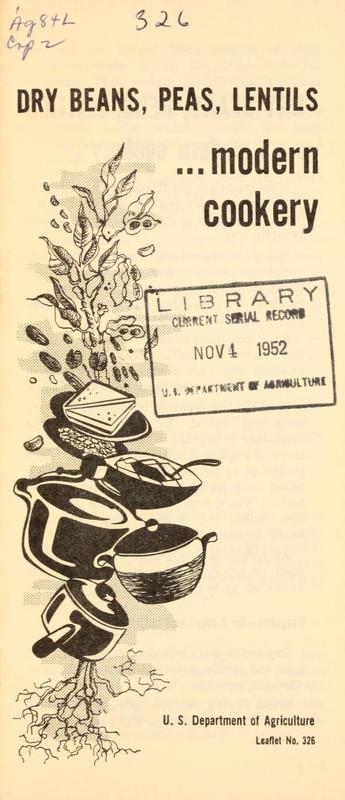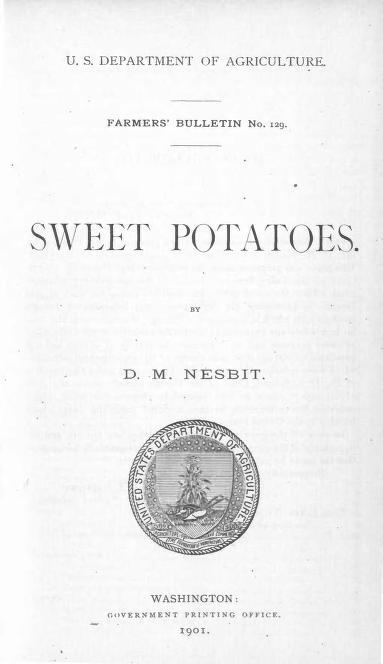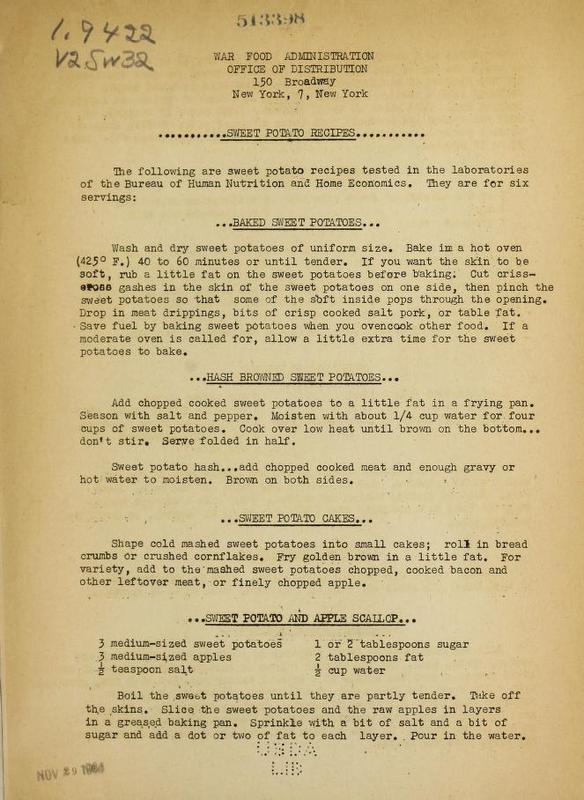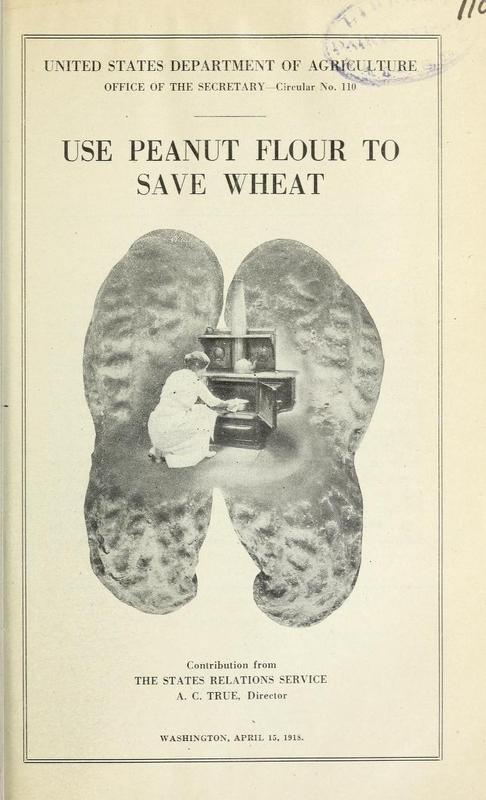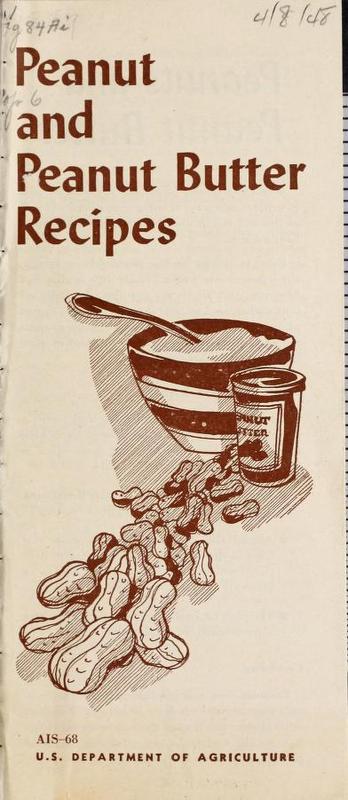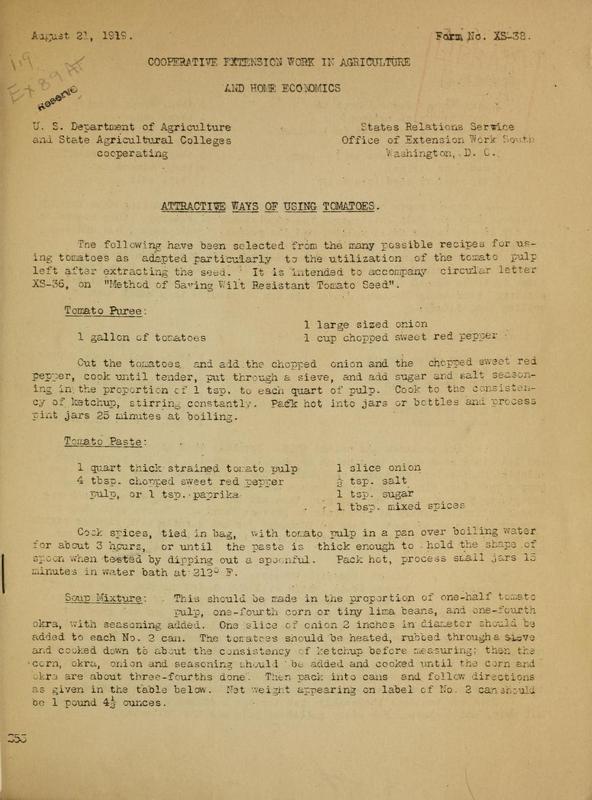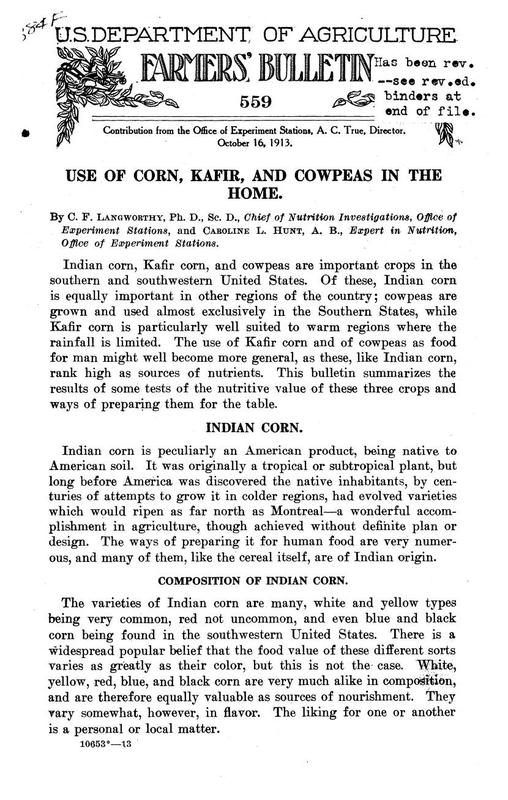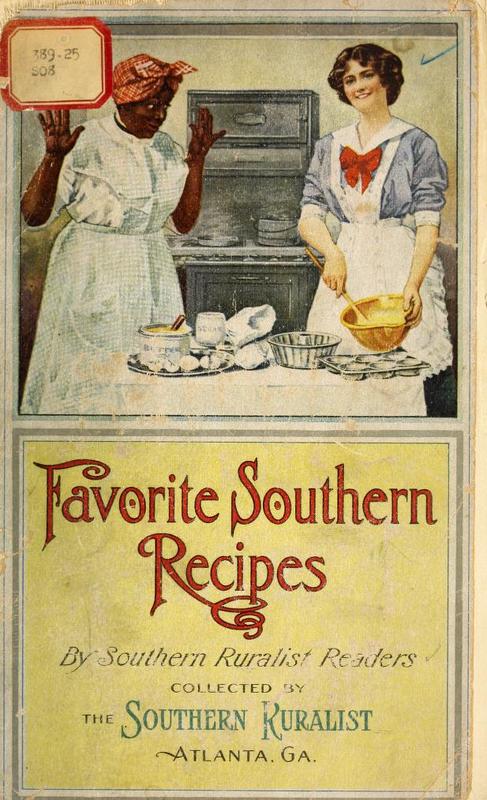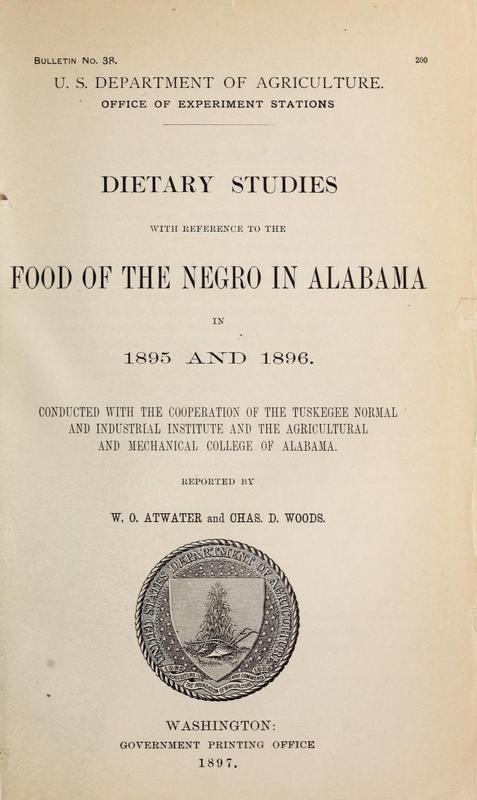USDA Historical Cooking Directions and Recipes
The U.S. Department of Agriculture has a long history of writing and publishing materials to help the home cook.
Here is a small sample of historical USDA documents that include the base farm products that Carver addressed in his bulletins, along with two other publications that reflect attitudes toward food, nutrition, and black citizens of the time.
(Click any image in this exhibit to get more information, including access to full text)
"Hopping John
A Southern favorite . . .
½ cup dry blackeye or pinto beans
2 1/4 or 3 cups ham broth
½ cup chopped cooked ham
½ cup rice
Salt and pepper
Soak beans in ham broth by the short method (see p. 6), using 2 1/4 cups broth for the blackeye beans, 3 cups for pinto beans. Do not soak overnight in broth.
Boil beans gently in broth until they are almost done (see p. 6).
Add ham and rice and cook covered until rice is done — about 20 to 30 minutes, depending on kind of rice. The liquid should be almost cooked away by the time the rice is tender. If there is too much liquid as the mixture cooks, take off the cover the last 10 minutes and turn up the heat. If the mixture seems too dry, add more ham broth.
4 servings."
"HOW TO COOK SWEET POTATOES
The delicate flavor of a sweet potato is lost if it is not cooked properly. Steaming develops and preserves the flavor better than boiling, and baking better than steaming.
A sweet potato cooked quickly is not well cooked. Time is an essential element. Twenty minutes may serve to bake a sweet potato so that a hungry man can eat it, but if flavor is an object, it should be kept in the oven an hour. The negroes of the South have a way of baking sweet potatoes in ashes covered with coals. They are often put in the ashes after one meal and left there while the negroes are working in the field, to be ready for the next meal. Hence, their fine flavor."
"The following are sweet potato recipes tested in the laboratories of the Bureau of Human Nutrition and Home Economics, They are for six servings:
. . . BAKED SWEET POTATOES . . .
Wash and dry sweet potatoes of uniform size. Bake in a hot oven (42.5° F.) 40 to 60 minutes or until tender. If you want the skin to be soft, rub a little fat on the sweet potatoes before baking; Cut criss-cross gashes in the skin of the sweet potatoes on one side, then pinch the sweet potatoes so that some of the soft inside pops through the opening. Drop in meat drippings, bits of crisp cooked salt pork, or table fat.
Save fuel by baking sweet potatoes when you ovencook other food. If a moderate oven is called for, allow a little extra time for the sweet potatoes to bake."
"Quick breads, such as biscuits, griddle cakes, waffles, and muffins, are much better forms for saving wheat than yeast breads, as more of the peanut flour can be used. All of these hot breads are good, and they are also good warmed over for another meal if you have baked more than you needed the first time.
PEANUT FLOUR-CORN MEAL GRIDDLE CAKES OR WAFFLES
1½ cups peanut flour
1 teaspoon salt
1½ cups corn meal
3 cups milk
¼ cup corn sirup
3 teaspoons baking powder
3 eggs"
"Peanut-Meat Loaf
1 ½ cups ground beef
1 cup finely chopped salted peanuts
¾ cup fine crumbs
1 egg
½ cup milk
1 tablespoon tomato catsup
2 tablespoons minced onion
½ teaspoon dry mustard
½ teaspoon Worcestershire sauce, if desired
1 teaspoon salt
Combine ingredients lightly. Bake in a greased loaf pan in a moderate oven (350 degrees F) about 1 hour. Serve with tomato sauce.
Six servings"
"The following have been selected from the many possible recipes for using tomatoes as adapted particularly to the utilization of the tomato pulp left after extracting the seed. It is intended to accompany circular letter XS-36, on 'Method of Saving Wilt Resistant Tomato Seed.'
Tomato Puree:
1 large sized onion
1 gallon of tomatoes
1 cup chopped sweet red pepper
Cut the tomatoes, and add the chopped onion and the chopped sweet red pepper, cook until tender, put through a sieve, and add sugar and salt seasoning in. the proportion of 1 tsp, to each quart of pulp. Cook to the consistency of ketchup, stirring constantly. Pack hot into jars or bottles and process pint jars 25 minutes at boiling."
"The cowpea is a member of a large botanical family known as the Leguminosse, whose fruit or seeded pods are called legumes. It is said to be native to Africa and early in the eighteenth century was introduced into the United States by way of the West Indies. Gradually it spread northward and late in the century we have record of its cultivation as an experimental crop on George Washington's farm in Virginia. Because of the great length of time it requires to reach maturity, it can not be raised to mature its seed in the Northern States. In the South, however, it is cultivated extensively as a forage crop, for fodder, and also for human food. A large number of varieties with seeds of many shapes, sizes, and colors have been identified and named.
The cowpea is distinguished among the legumes for the peculiarly delicate and pleasing flavor of many varieties. It seems strange, therefore, that, though generally and favorably known as a staple food in the Southern States, it has not come into more general use in the dietary of the United States as a whole. Its failure to do so is probably attributable to the fact that no great effort has been made to create a general market for it. It is well worth very greatly extended use, as it is a wholesome, nutritious foodstuff from which a variety of palatable as well as economical dishes can be made.
Cowpeas are used on the table in three forms: In the pod, shelled green, and shelled dried. In these three forms they correspond, respectively, to string beans, shelled green peas, and dried navy beans, and call for much the same methods of preparation for the table."
"THIN WHITE SAUCE
Two cups of milk, two tablespoonsful of flour, two tablespoonsful of butter. Scald milk, melt the butter, stir the flour in the melted butter ; do not cook. Gradually add part of hot milk, stirring well ; add remainder of milk, cook over hot water. This sauce may be used as the foundation of soups. — Mrs. A. Johnson, Lyons, Texas.
MUTTON BROTH
Put two pounds of mutton and two quarts of cold water to boil, add one tablespoonful of rice, washed carefully through several waters. Let it boil till the meat will leave the bone and the rice is cooked to a liquid mass. Take from the fire, season with a little salt, and skim if preferred. If for a patient, leave on all the fat (the more fat, the better). — Jewel Taylor, Winnsboro, Louisiana.
VEGETABLE SOUP
After boiling a soup bone or a piece of beef until done, add to the broth boiling water to make the amount of soup wanted, and when boiling again, add a large handful of cabbage cut fine as for slaw, a half pint of tomatoes and three good-sized onions, cut fine, and three Irish potatoes sliced very thin, and a half pint of corn. Let boil about a half hour. If the soup is liked a little thick, beat one egg with two tablespoonsful of sweet milk and one teaspoonful of flour put in five or ten minutes before taking off. This makes it very rich. Serve with crackers. Try this straight, then sweeten to taste. Also add pepper, salt, and a little butter. — Miss Rosa Fekrell, Durham, N. G."
"The purpose of this bulletin is to give an account of studies of the food and nutrition of negroes in the neighborhood of Tuskegee, Ala. The investigation was made during the spring of 1895 and the winter of 1895-96, with the cooperation of the Normal and Agricultural Institute at Tuskegee and of the Alabama Agricultural and Mechanical College at Auburn.
The investigation includes examinations of 20 dietaries of 18 families. Some of the families lived in and close by the village of Tuskegee; the majority were on plantations from 2 to 9 miles distant. Some of the families, especially those in and near the village, showed by their improved conditions of living the noteworthy influence of the Institute and of association with people of intelligence and thrift. The same was true of some of the plantation families. The rest were very much like the ordinary plantation negroes, and were, indeed, selected as typical examples of the great mass of the colored people of this region. A number of the families were on a large plantation where the mortgage system prevails, and the plane of living is a very low one. The people studied represent the gradation from the lower to the higher grade of living which actually exists among the negroes in Alabama, and the observations thus help to illustrate not only the evils under which the colored people live, but some of the phases through which they are passing in their upward progress.
While the main subject is the food and nutrition of typical negro families in a representative district of the South, other observations pertaining to their conditions of life are also reported.
The general plan consisted in visiting each house or cabin from day to day for a period generally of two weeks, weighing the food used by the family, and taking specimens for analysis, notes being made at the same time regarding the people, their dwellings, farms, work, habits, and the like."
 An official website of the United States government.
An official website of the United States government.


